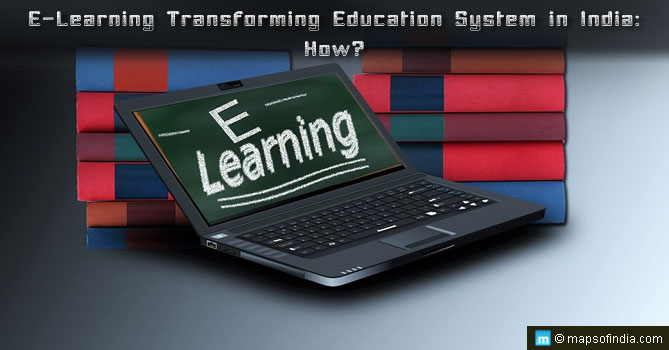E-learning industry in India is increasing at a rate of over 20% on a year-on-year basis. It is estimated to become a US$1.96 billion industry by 2021. Reports say digital education in India already has a vast network. It is connected to over 1.5 million schools and 18,000 higher education institutes.
The paid online subscribers in the edtech sector are also witnessing a massive surge. While in 2016, the total paid subscribers were around 1.6 million, reports suggest that by 2021 it is going to increase 6 times to reach a massive 9.6 million.
E-learning is also witnessing paradigm shift in its approach, implementation, adoption, and technological development. Some of the latest in the field of digital education include cloud-based platforms, ICT classrooms, Virtual Reality (VR), Augmented Reality (AR), and others.
All these innovative technological advancements are not luxuries anymore. These digital tools and their implementation have become necessities in schools to come out of the theory-based learning to a more practical-oriented one. Technological interventions make education engaging by incorporating interactive media as well as visual animations.
Superior Technological Intervention Aiding e-Learning in India
The education-technology sector primarily eases the learning process of a student. At first it generates lots of data for analysis. These analyzed data are used to understand individual academic needs of students and natural flair for learning.
With the help of this analysis and keeping a tab on individual student’s progress, the edtech sector provides efficient pedagogical training through extensive personalization. The derived insights from the in-depth data analysis have the potential of enhancing education system in entirety. In fact, the insights can also help in progression of courses as well as skill development of teachers.
- Artificial Intelligence, Machine Learning, & Big Data
The e-learning industry is on the verge of a paradigm shift with the help of artificial intelligence. In fact, machine learning (which is basically a subset of artificial intelligence) is already being employed to enhance quality education.
Machine learning is combining many aspects such as:
- Comparing the actual time taken by a student with respect to the average time taken in answering a specific question.
- Ability of a student in answering the question correctly.
- A student’s performance on a related topic, and much more
Through this multifaceted analytical approach, machine learning handcrafts the effective approach of education as well as course progression of a student.
In fact, Big Data is also employed to analyze the collated data and bring out the core and additional insights. It further helps the edtech platforms to accurately create student profiles and consequently customize their styles of teaching in accordance with the most effective pedagogical model.
- Content Distribution Networks (CDNs)
CDN-based content dissemination is the latest technological advancement incorporated in the e-learning industry. It has been found out that video re-buffering stops 2/3rd of the viewers from watching a video. No matter how engaging content is, buffering makes online viewers stop watching videos. Content Distribution Networks or CDNs address this problem. With CDNs, buffering of videos can be ironed out as the content is served to the user from the nearest located data center, providing students get unhindered view of the video.
How is E-Learning Helping Education in India?
E-learning is impacting the higher education in 3 ways:
- Increasing Access to Education
E-learning is letting the students learn from their professors and teachers right from their homes and hostels by using internet-connected computers, tablets, and smartphone. Some of the more advanced skills such as machine learning and artificial intelligence are still not accessible to many students in India because of many infrastructural issues. These constraints are mainly seen in the tier II/III cities.
Access to teachers and educators can be ironed out easily with the help of e-learning approach. The Union Ministry of Human Resources and Development as well as the skill development bodies of different Indian states (such as APSSDC) have understood the effectiveness of e-learning. That’s why they have started to upload lectures online so that students can access them anytime and anywhere.
- Providing Quality Education to Students
There are only a handful of premier colleges in India. In comparison to the increasing number of higher education students, the seats are severely limited. That’s why most of the higher education students can’t get quality education.
An MHRD report of 2017 revealed that some Indian schools don’t have the required number of teachers. This high student to teacher ratio is adversely affecting the education quality. While the teachers can’t provide personalized focus on each student in the classroom, the students can’t utilize their time spent in the classroom fully and qualitatively.
The world is also changing with evolving technology. Different fields of study are also witnessing changes almost on a daily basis. However, these changes are not included in the syllabus. That’s’ why students don’t get updated information through traditional education.
This is where online learning has become so effective in providing quality education. E-learning facilities also help students get personalized tips from professors and professionals, bringing quality education to students.
E-learning is also making the entire learning experience fun-filled by including quizzes, challenges, practical-oriented, and engaging. In fact, the online education facility is more engaging than classroom learning.
- Making Education more Affordable
Parents have to shell out large amount of money to provide quality education to their children, right from school to college. Reports suggest that the cost associated with higher education at traditional brick-and-mortar colleges are significantly higher than the one-time cost associated with online learning.
In case of traditional college education, you have to spend on commute or lodging. However, online education can be done right from your home. Therefore, with the advent of e-learning resources, students can access education at a much lower cost.
Conclusion
E-learning courses make you job-ready. The education can be imparted in accordance with the true interests of the students in the most effective and efficient way possible. This increases employability of the students, helping them to get employed after successfully completing their education. That’s how e-learning is bringing the coveted change in the entire education system in India.





